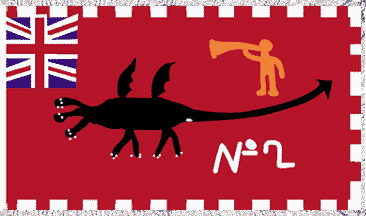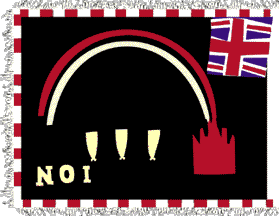
Last modified: 2006-03-18 by antonio martins
Keywords: canton: union jack | car | tree | dead | checkers | dragon | nº2 | trumpet | megaphone | rainbow | gong | bell | lion | no1 |
Links: FOTW homepage |
search |
disclaimer and copyright |
write us |
mirrors

An abstract flag with a Union Jack in the canton. The border contains
narrow Black and White fields, which makes the static patterns moving somehow.
The chessboard is a secret code for a scene in which two opponents play a
startegic boardgame. Like the African Oware-game the Game of Checkers is
a metaphore for war. Images of checkers-players are known in the Asafo
iconography.
The way the Union Jack is made points at the same maker as flags 23-25
and 72.
Jarig Bakker, 06 Jan 2000, quoting
[gru95]

This dragon is a remarkable formal representation of the proverb: "He
can fly and penetrate the earth, he can go whereever he wants to go."
Wings and arrow-pointed tail point at his exceptional capabilities. As a
total figure the Dragon has been turned towards the left; the way in
which wings and legs are related look like two figures, who travel in
the opposite direction than the Dragon. So: a-a watch it!: the Dragon
can travel in any direction!
Jarig Bakker, 06 Jan 2000, quoting
[gru95]
The text from [gru95] fails to mention
the inscription "Nº2" and also the orange human figure holding a
megaphone/trumpet.
António Martins, 03 Jun 2004

Three gong-gongs as symbol for the state of alarm of the company is
combined on this flag with the image of a Posuban-shrine, from which a
rainbow ascends. This rainbow is a symbol for death, for like the
rainbow folds itself around someone’s neck, so is death the fate which
threatens us all.
The company underlines with this symbol the deadly danger it presents to
its enemies.
Jarig Bakker, 07 Jan 2000, quoting
[gru95]

A big man evades frightened a group of armed women. The scene
illustrates the power of a company by the revelation of force of its
weakest members: the women: «When even our women have been prepared for
war, what are our men capable of?» This theme is not uncommon; it is to
be found equally on flags and Posuban-shrines.
Stylistically this flag is related to those from the workshop of Ekotsi;
there are some differences in the proportioning and the Union Jack has
been depicted differently.
Jarig Bakker, 04 Jan 2000, quoting
[gru95]

Weighing always implies comparison. When the Sahohen puts a fallen
warrior on a scale, he evokes revenge, for «no head weighs as much like
the one on the scales: the losses on your own side always weigh the
heaviest.»
The whole background of this flag was restored with the same tissue as
the old silk, which had been used until it was worn out.
Jarig Bakker, 04 Jan 2000,
quoting [gru95]
The warrior on the left holds the scales in his left hand; the scales
consist of thin white lines: top a horizontal line, from which depend
two pyramides, left and right, which both and in disks with three
concentric circles. Between the pyramids are small yellow objects. The
bottom foot of the fallen warrior is on top of some yellow objects.
Thanh-Tâm Lê, 04 Jan 2000
This flag is hard to describe, but here goes: a colourful fringed flag
with a Union Jack in the canton. Part of the border is fringed with an
unusual green and white geometrical pattern. There is a large human?
figure below the Union Jack, gesturing? at a gate? with a padlock? Behind the
gate is another figure by a car. Above the gate in a black field are
the words in white capitals ROAD CLOSE.
David Cohen, 21 Jun 1998